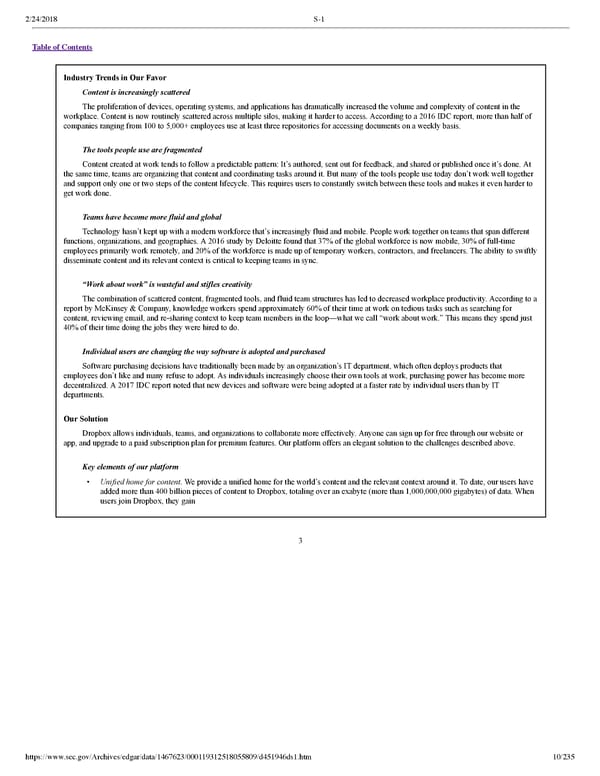2/24/2018 S-1 Table of Contents Industry Trends in Our Favor Content is increasingly scattered The proliferation of devices, operating systems, and applications has dramatically increased the volume and complexity of content in the workplace. Content is now routinely scattered across multiple silos, making it harder to access. According to a 2016 IDC report, more than half of companies ranging from 100 to 5,000+ employees use at least three repositories for accessing documents on a weekly basis. The tools people use are fragmented Content created at work tends to follow a predictable pattern: It’s authored, sent out for feedback, and shared or published once it’s done. At the same time, teams are organizing that content and coordinating tasks around it. But many of the tools people use today don’t work well together and support only one or two steps of the content lifecycle. This requires users to constantly switch between these tools and makes it even harder to get work done. Teams have become more fluid and global Technology hasn’t kept up with a modern workforce that’s increasingly fluid and mobile. People work together on teams that span different functions, organizations, and geographies. A 2016 study by Deloitte found that 37% of the global workforce is now mobile, 30% of fulltime employees primarily work remotely, and 20% of the workforce is made up of temporary workers, contractors, and freelancers. The ability to swiftly disseminate content and its relevant context is critical to keeping teams in sync. “Work about work” is wasteful and stifles creativity The combination of scattered content, fragmented tools, and fluid team structures has led to decreased workplace productivity. According to a report by McKinsey & Company, knowledge workers spend approximately 60% of their time at work on tedious tasks such as searching for content, reviewing email, and resharing context to keep team members in the loop—what we call “work about work.” This means they spend just 40% of their time doing the jobs they were hired to do. Individual users are changing the way software is adopted and purchased Software purchasing decisions have traditionally been made by an organization’s IT department, which often deploys products that employees don’t like and many refuse to adopt. As individuals increasingly choose their own tools at work, purchasing power has become more decentralized. A 2017 IDC report noted that new devices and software were being adopted at a faster rate by individual users than by IT departments. Our Solution Dropbox allows individuals, teams, and organizations to collaborate more effectively. Anyone can sign up for free through our website or app, and upgrade to a paid subscription plan for premium features. Our platform offers an elegant solution to the challenges described above. Key elements of our platform • Unified home for content. We provide a unified home for the world’s content and the relevant context around it. To date, our users have added more than 400 billion pieces of content to Dropbox, totaling over an exabyte (more than 1,000,000,000 gigabytes) of data. When users join Dropbox, they gain 3 https://www.sec.gov/Archives/edgar/data/1467623/000119312518055809/d451946ds1.htm 10/235
 Dropbox S-1 | Interactive Prospectus Page 9 Page 11
Dropbox S-1 | Interactive Prospectus Page 9 Page 11